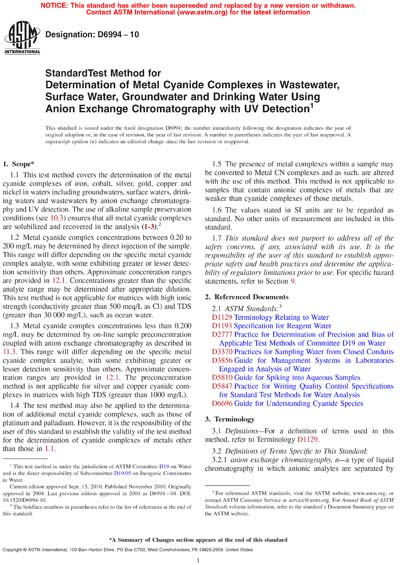Historical
ASTM D6994-10
Standard Test Method for Determination of Metal Cyanide Complexes in Wastewater, Surface Water, Groundwater and Drinking Water Using Anion Exchange Chromatography with UV Detection
1.1 This test method covers the determination of the metal cyanide complexes of iron, cobalt, silver, gold, copper and nickel in waters including groundwaters, surface waters, drinking waters and wastewaters by anion exchange chromatography and UV detection. The use of alkaline sample preservation conditions (see 10.3) ensures that all metal cyanide complexes are solubilized and recovered in the analysis (1-3).
1.2 Metal cyanide complex concentrations between 0.20 to 200 mg/L may be determined by direct injection of the sample. This range will differ depending on the specific metal cyanide complex analyte, with some exhibiting greater or lesser detection sensitivity than others. Approximate concentration ranges are provided in 12.1. Concentrations greater than the specific analyte range may be determined after appropriate dilution. This test method is not applicable for matrices with high ionic strength (conductivity greater than 500 meq/L as Cl) and TDS (greater than 30 000 mg/L), such as ocean water.
1.3 Metal cyanide complex concentrations less than 0.200 mg/L may be determined by on-line sample preconcentration coupled with anion exchange chromatography as described in 11.3. This range will differ depending on the specific metal cyanide complex analyte, with some exhibiting greater or lesser detection sensitivity than others. Approximate concentration ranges are provided in 12.1. The preconcentration method is not applicable for silver and copper cyanide complexes in matrices with high TDS (greater than 1000 mg/L).
1.4 The test method may also be applied to the determination of additional metal cyanide complexes, such as those of platinum and palladium. However, it is the responsibility of the user of this standard to establish the validity of the test method for the determination of cyanide complexes of metals other than those in 1.1.
1.5 The presence of metal complexes within a sample may be converted to Metal CN complexes and as such, are altered with the use of this method. This method is not applicable to samples that contain anionic complexes of metals that are weaker than cyanide complexes of those metals.
1.6 The values stated in SI units are to be regarded as standard. No other units of measurement are included in this standard.
1.7 This standard does not purport to address all of the safety concerns, if any, associated with its use. It is the responsibility of the user of this standard to establish appropriate safety and health practices and determine the applicability of regulatory limitations prior to use. For specific hazard statements, refer to Section 9.
Content Provider
ASTM International [astm]






